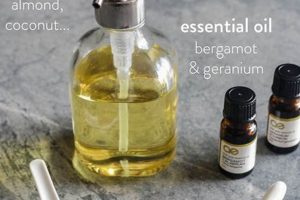The subject under consideration involves the creation of hair conditioning treatments designed for application and retention without rinsing. These formulations, typically crafted from readily available household ingredients, aim to provide sustained hydration and manageability to hair strands. An example includes a mixture of coconut oil, aloe vera gel, and essential oils blended to create a nourishing emollient.
Formulating such preparations allows for personalized hair care routines, addressing specific needs related to hair type, texture, and environmental exposure. The practice offers potential cost savings compared to commercially produced counterparts and promotes the use of natural, minimally processed components. Historically, the practice stems from a desire for customizable and readily accessible grooming solutions, evolving alongside increased awareness of ingredient sourcing and potential chemical sensitivities.
The subsequent discussion will explore various recipes, ingredient considerations, application techniques, and potential challenges associated with creating effective hair treatments for sustained conditioning. It will also address safety precautions and storage guidelines to ensure optimal product performance and user well-being.
Formulating Effective Hair Conditioners for Sustained Application
The following guidelines provide practical advice for successfully creating hair treatments intended for leave-in use. Emphasis is placed on ingredient selection, preparation methods, and application techniques to maximize product efficacy and minimize potential adverse effects.
Tip 1: Prioritize Hydration. Employ humectants such as aloe vera juice or vegetable glycerin to attract and retain moisture within the hair shaft. Their inclusion mitigates dryness and enhances suppleness.
Tip 2: Emphasize Emollience. Incorporate oils such as argan, jojoba, or sweet almond oil to impart smoothness, reduce frizz, and improve detangling capabilities. The choice of oil should align with individual hair porosity and sensitivity.
Tip 3: Control Protein Levels. If hair requires strengthening, hydrolyzed proteins (e.g., silk or wheat) can be added in moderation. Excessive protein can lead to rigidity and breakage, thus careful calibration is essential.
Tip 4: Ensure Proper Preservation. Homemade formulations lack the robust preservative systems of commercial products. Store creations in a refrigerator and discard after one week to prevent microbial growth.
Tip 5: Conduct Patch Testing. Before widespread application, apply a small amount of the created treatment to an inconspicuous area of skin to assess for allergic reactions or sensitivities.
Tip 6: Adjust Consistency. Modify the ratio of liquid to solid ingredients to achieve a desired texture. Sprays often require a higher liquid content, while creams necessitate thickening agents like shea butter or beeswax.
Tip 7: Apply Strategically. Focus application on the mid-lengths and ends of hair, avoiding the scalp to prevent greasiness and product buildup.
Adherence to these guidelines will enhance the likelihood of producing a beneficial and effective hair treatment. Careful ingredient selection and meticulous preparation are paramount for optimal results.
The subsequent section will address common troubleshooting issues encountered during the creation and application of these treatments and provide strategies for resolution.
1. Hydration Retention
Hydration retention is a central factor determining the effectiveness of hair treatments intended for sustained, un-rinsed application. The capability of a given formulation to maintain moisture within the hair shaft directly impacts its ability to improve manageability, reduce frizz, and enhance overall hair health. The success of these treatments relies on optimizing hydration within the hair structure.
- Humectant Incorporation
The inclusion of humectants, such as glycerin or honey, attracts moisture from the environment into the hair. In the context of self-made conditioning treatments, selecting appropriate humectants and controlling their concentration is critical. Excessive use may lead to stickiness or product build-up, while insufficient quantities may render the formulation ineffective. The environmental humidity levels also influence the efficacy of humectant-containing products. For instance, in arid climates, humectants may draw moisture from the hair itself, leading to dryness, unless balanced with occlusive ingredients.
- Emollient Integration
Emollients, such as oils and butters, create a hydrophobic barrier on the hair surface, reducing water loss. Their role in formulations designed for leave-in application extends beyond simple moisturizing; they contribute to sealing in the hydration provided by humectants and water-based ingredients. The choice of emollient influences the final texture and feel of the treatment, as well as its compatibility with different hair types. Lightweight oils, such as argan or grapeseed, are often preferred for fine hair, while heavier butters, like shea or cocoa, are suitable for thicker, coarser textures.
- pH Balancing Considerations
The pH of the treatment can influence the hair’s ability to retain moisture. Maintaining a slightly acidic pH, similar to that of the hair’s natural sebum, helps to close the hair cuticles, reducing moisture loss and improving shine. Incorporating ingredients like apple cider vinegar or citric acid, in carefully measured quantities, can assist in pH adjustment. However, excessive acidity may lead to hair damage, necessitating precise formulation and monitoring.
- Protein-Moisture Equilibrium
The balance between protein and moisture is essential for maintaining hair health and hydration. Excessive protein application can render hair brittle and prone to breakage, while insufficient protein may lead to limpness and lack of elasticity. When formulating leave-in treatments, the protein content should be carefully controlled, and balanced with adequate moisture-retaining ingredients to ensure optimal hair condition and hydration.
The principles of hydration retention are fundamentally linked to the overall effectiveness of hair conditioning treatments intended for leave-in application. The strategic selection and balanced incorporation of humectants, emollients, pH adjusters, and protein sources allows for the creation of formulations that not only provide initial hydration but also sustain moisture levels over extended periods, contributing to improved hair health and manageability.
2. Ingredient Compatibility
The successful formulation of hair conditioning treatments for sustained application hinges critically on ingredient compatibility. In
compatibility can lead to compromised product efficacy, undesirable aesthetic properties, or, in severe cases, adverse reactions. Careful consideration of how individual components interact is thus paramount to ensuring the safety and performance of self-prepared formulations.
- pH Interactions
The pH level of individual ingredients can significantly impact the stability and efficacy of the final product. Certain ingredients may only function optimally within a specific pH range. Combining components with drastically different pH levels can neutralize active compounds or induce unwanted chemical reactions. For example, the alkaline nature of baking soda will neutralize acidic ingredients like apple cider vinegar, impacting their intended benefits if included in the same formula without proper consideration.
- Oil and Water Emulsification
The mixture of oil and water phases necessitates the use of emulsifiers to prevent separation. Incompatible ratios or inadequate emulsification can result in an unstable, greasy, or aesthetically unappealing product. For instance, combining a large volume of coconut oil with a small amount of water without a suitable emulsifier will lead to phase separation, rendering the product uneven and less effective in delivering hydration.
- Preservative System Interactions
Homemade formulations lack the robust preservative systems of commercial products. Certain natural preservatives may be incompatible with specific ingredients, rendering them ineffective against microbial growth. For example, the antimicrobial properties of grapefruit seed extract may be compromised by the presence of certain oils, leading to spoilage and potential contamination.
- Cationic and Anionic Interactions
The combination of cationic (positively charged) and anionic (negatively charged) ingredients can lead to the formation of insoluble precipitates. This is particularly relevant when incorporating certain surfactants or polymers. In such cases, the product will cloud, become less effective, and may even leave a residue on the hair.
Therefore, a thorough understanding of ingredient properties and their potential interactions is crucial for creating effective hair conditioning treatments for sustained application. Ignoring these considerations can lead to unsatisfactory results, product instability, or adverse reactions. Careful research and experimentation are essential to ensure the compatibility of all components within the formulation.
3. Application Technique
The method of application significantly influences the efficacy of hair conditioning treatments created for sustained, un-rinsed use. Inadequate application can negate the benefits of a well-formulated product, while a strategic approach maximizes its potential.
- Distribution Uniformity
Achieving even distribution across the hair strands is crucial. Uneven application leads to inconsistent results, with some areas receiving insufficient conditioning while others experience product buildup. Using a wide-tooth comb or fingers to carefully distribute the treatment ensures that all strands are adequately coated. For thicker hair, sectioning the hair prior to application facilitates more thorough coverage. Concentrating the product on the mid-lengths and ends, where damage is typically more pronounced, is generally recommended. Avoid applying directly to the scalp, as this can lead to greasiness and clogged pores.
- Quantity Control
The amount of product used dictates the outcome. Overapplication results in weighed-down, greasy hair, while insufficient use fails to deliver the intended benefits. The appropriate quantity varies depending on hair length, thickness, and porosity. Start with a small amount and gradually increase as needed, observing how the hair responds. Fine hair requires less product than thick hair. Porous hair, which absorbs moisture readily, may require a slightly larger quantity compared to less porous hair.
- Application Timing
Applying the treatment to damp, rather than soaking wet, hair optimizes absorption. When hair is excessively wet, the water barrier prevents the product from penetrating the hair shaft effectively. Gently towel-drying the hair to remove excess water before application allows the conditioning agents to be absorbed more readily. Additionally, the timing of application within the overall hair care routine influences the outcome. Applying after washing and before styling products allows the treatment to provide a protective layer and facilitate manageability.
- Product Incorporation
Some hair treatments will incorporate better into wet hair, or dry hair. Dry hair can get a good coat but take longer. Using a wet hair allows the product to spread and coat the hair from the start.
Proper application technique is essential for realizing the full potential of self-made hair conditioning treatments intended for sustained application. Achieving uniform distribution, controlling the quantity applied, and optimizing the timing of application are all critical factors that influence the final result, contributing to improved hair health and manageability.
4. Preservation Methods
The longevity and safety of hair conditioning treatments created for sustained application are intrinsically linked to the preservation methods employed. Due to the absence of robust preservation systems common in commercially manufactured products, homemade formulations are susceptible to microbial contamination and degradation, necessitating specific techniques to mitigate these risks.
- Refrigeration
Storing self-made formulations in a refrigerator retards microbial growth by slowing down metabolic processes. This is a practical, albeit temporary, preservation strategy. Refrigeration is most effective when coupled with other preservation techniques and when formulations are used within a limited timeframe, typically one week. However, refrigeration can alter the viscosity and texture of certain ingredients, such as oils and butters, potentially affecting the product’s application and performance.
- Antimicrobial Ingredients
Incorporating natural antimicrobial agents, such as grapefruit seed extract, tea tree oil, or rosemary extract, can inhibit microbial proliferation. The concentration and efficacy of these ingredients vary, and their compatibility with other formulation components must be verified. Overuse may cause scalp irritation or allergic reactions, while insufficient quantities may fail to provide adequate preservation. Furthermore, the pH of the formulation can impact the effectiveness of certain antimicrobial agents.
- Sterilization of Equipment
Thoroughly sterilizing all equipment used in the preparation process, including mixing bowls, utensils, and storage containers, minimizes initial microbial load. Boiling, autoclaving, or using a sanitizing solution are common methods for sterilization. Neglecting this step introduces contaminants that can accelerate spoilage. The choice of storage container also matters; airtight, opaque containers are preferred to prevent oxidation and exposure to light, which can degrade ingredients.
- Limiting Water Content
Water provides a medium for microbial growth. Reducing the water content of the formulation, when feasible, enhances its stability. Formulations based primarily on anhydrous ingredients, such as oils and butters, are inherently less susceptible to microbial contamination than those with a high water content. When water is necessary, using distilled or purified water minimizes the introduction of contaminants.
Effective preservation methods are indispensable for ensuring the safety and extended usability of hair conditioning treatments designed for sustained application. The selection and implementation of these methods necessitate careful consideration of ingredient properties, potential interactions, and storage conditions to mitigate the risk of microbial contamination and maintain product efficacy.
5. Scalp Sensitivity
Scalp sensitivity represents a critical consideration when formulating hair conditioning treatments intended for prolonged application and retention. The scalp, being an extension of the skin, exhibits varying degrees of susceptibility to irritation and allergic reactions, particularly when exposed to exogenous substances. Therefore, meticulous ingredient selection and formulation practices are paramount to minimize adverse effects.
- Irritant Potential of Ingredients
Certain commonly used components possess inherent irritant properties. Essential oils, while often included for their purported benefits, contain potent volatile compounds that can provoke inflammatory responses in sensitive individuals. Similarly, preservatives, necessary to prevent microbial growth, may trigger contact dermatitis in susceptible scalps. Thorough research into the irritancy profile of each ingredient is essential. Example: Tea tree oil, while possessing antimicrobial properties, can cause significant irritation if used undiluted or at high concentrations on a sensitive scalp.
- Occlusive Nature of Formulations
Treatments designed for sustained application inherently possess occlusive properties, impeding the scalp’s natural respiration and potentially leading to the accumulation of sebum and cellular debris. This occlusion can exacerbate pre-existing conditions such as seborrheic dermatitis or psoriasis. Lightweight, non-comedogenic ingredients should be prioritized to minimize this effect. Example: Heavy butters and oils, while moisturizing, may create an impermeable barrier, trapping irritants and exacerbating scalp inflammation.
- pH Imbalance and Scalp Disruption
The scalp maintains an acidic pH, which serves as a protective barrier against microbial colonization. Formulations with extreme pH levels can disrupt this natural balance, compromising the scalp’s defense mechanisms and increasing its vulnerability to irritation and infection. Monitoring and adjusting the pH of the final product to align with the scalp’s natural acidity is crucial. Example: Alkaline ingredients, such as baking soda, can elevate the scalp’s pH, disrupting the acid mantle and promoting bacterial overgrowth.
- Allergenic Compounds and Sensitization
Some individuals possess pre-existing sensitivities or may develop allergies to specific compounds present in conditioning treatments. Continued exposure to these allergens can trigger allergic contact dermatitis, characterized by itching, redness, and inflammation. Conducting patch tests prior to widespread application is imperative to identify potential allergens. Example: Fragrances, both natural and synthetic, are common allergens and should be used sparingly or avoided altogether in formulations intended for individuals with sensitive scalps.
In summary, mitigating the risk of adverse reactions in individuals with scalp sensitivities necessitates a comprehensive understanding of ingredient properties, formulation dynamics, and appropriate application practices. Prioritizing gentle, non-irritating components, minimizing occlusion, maintaining pH balance, and conducting thorough testing are essential steps in creating safe and effective hair conditioning treatments for sustained application.
6. Hair Porosity
Hair porosity, referring to the hair’s ability to absorb and retain moisture, is a critical determinant in the effectiveness of conditioning treatments designed for sustained application. The structural characteristics of the hair cuticle, whether tightly bound or more open, dictate the rate and extent to which moisture and conditioning agents can penetrate the hair shaft. Formulations developed without consideration for this inherent hair property may prove either ineffective or detrimental.
Individuals with low porosity hair, characterized by a tightly closed cuticle, often experience product buildup as conditioning agents struggle to penetrate the hair shaft. In these cases, lightweight formulations with smaller molecular sizes, applied with heat to encourage cuticle opening, are generally more beneficial. Conversely, high porosity hair, featuring a more open cuticle, readily absorbs moisture but also loses it quickly. Heavier formulations with moisture-sealing properties, such as those containing butters and oils, are better suited to retain hydration. A failure to tailor the formulation to the specific porosity can lead to either dryness, due to insufficient moisture retention, or weighed-down, greasy hair, due to excessive product accumulation. Consider, for example, the application of a heavy oil-based treatment to low porosity hair; the result would likely be a greasy residue without appreciable improvement in hydration. Conversely, a lightweight, water-based treatment applied to high porosity hair may evaporate rapidly, leaving the hair feeling dry and brittle.
Therefore, accurate assessment of hair porosity is a foundational step in formulating appropriate conditioning treatments for sustained application. By understanding how the hairs structure impacts its capacity to absorb and retain moisture, individuals can select or create formulations that effectively address their specific needs. Recognizing porosity is the key to addressing moisture needs for each hair, and will give the best result.
Frequently Asked Questions
The subsequent queries address common concerns and misconceptions surrounding the creation and application of self-made hair conditioning treatments intended for leave-in use. The aim is to provide clarity and practical guidance based on scientific principles and empirical observations.
Question 1: Are homemade hair treatments as effective as commercially produced products?
The efficacy of self-made formulations depends largely on the quality of ingredients and the precision of the formulation. Commercial products often contain scientifically optimized blends of synthetic and natural ingredients, including advanced delivery systems. However, properly formulated homemade treatments, utilizing high-quality, natural ingredients, can provide comparable benefits, particularly for individuals seeking to avoid specific chemicals or customize their hair care regimen.
Question 2: How can the shelf life of self-made hair treatments be extended?
Due to the absence of robust preservative systems, homemade formulations typically have a limited shelf life. Refrigeration, the incorporation of natural antimicrobial agents, and the use of sterile equipment can extend usability. Ho
wever, frequent monitoring for signs of spoilage, such as changes in odor, color, or texture, is essential. Discarding the product after one week is generally recommended to minimize the risk of microbial contamination.
Question 3: Can these treatments be used on color-treated hair?
Certain ingredients can affect color-treated hair. The pH of the formulation is particularly important, as extreme pH levels can alter hair color. Ingredients known to strip color, such as lemon juice or strong acids, should be avoided. Performing a strand test prior to widespread application is recommended to assess the impact on hair color.
Question 4: Are there specific ingredients that should be avoided in formulations for sensitive scalps?
Individuals with sensitive scalps should avoid ingredients known to cause irritation or allergic reactions, such as fragrances, essential oils (particularly undiluted), and harsh preservatives. Lightweight, non-comedogenic oils and humectants are generally better tolerated. Patch testing is crucial to identify potential allergens before full-scale application.
Question 5: How does hair porosity affect the choice of ingredients?
Hair porosity, which dictates the hair’s ability to absorb and retain moisture, significantly influences ingredient selection. Low porosity hair benefits from lightweight formulations with smaller molecular sizes, while high porosity hair requires heavier, moisture-sealing ingredients. Matching the formulation to the hair’s porosity optimizes product performance and minimizes adverse effects.
Question 6: Is it possible to create a leave-in treatment for oily hair?
Yes, but the formulation requires careful ingredient selection. Lightweight, water-based formulations with minimal oil content are preferable. Avoiding heavy butters and oils, and focusing application on the mid-lengths and ends, helps to prevent greasiness. Ingredients with astringent properties, such as witch hazel, may also be beneficial, but should be used sparingly to avoid drying out the hair.
In essence, the successful creation and application of self-made hair treatments for sustained application hinges on a thorough understanding of ingredient properties, formulation principles, and individual hair characteristics. Careful planning and adherence to safety guidelines are essential for achieving optimal results.
The subsequent section will offer concluding remarks and summarize key recommendations for readers seeking to create effective hair treatments at home.
Concluding Remarks
The preceding exploration of DIY leave-on conditioners has illuminated the complexities inherent in creating effective and safe hair treatments for sustained application. Key considerations include the crucial interplay of ingredient compatibility, preservation techniques, scalp sensitivity, and hair porosity. Successfully navigating these variables demands a meticulous approach to formulation and a commitment to ongoing evaluation of product performance.
The potential benefits of personalized hair care solutions remain significant. However, a thoughtful understanding of both the opportunities and the challenges is essential. The pursuit of optimal hair health through self-prepared treatments requires diligence, responsible experimentation, and a continuous commitment to informed decision-making.







